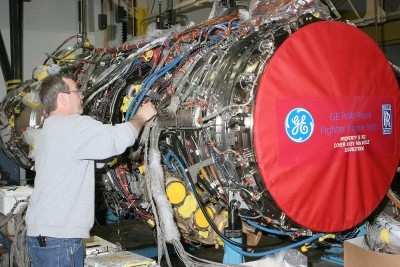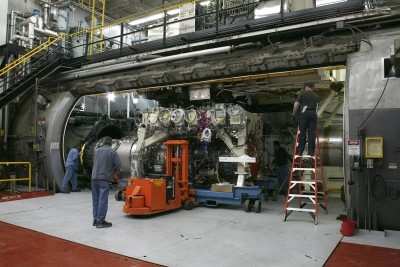Companies Say The Move Will Significantly Drive Down Costs,
Accelerate Engine Competition
 Despite what can only be described
as a lack of interest on the parts of the White House, the Pentagon
and many members of Congress, General Electric Co. and Rolls-Royce
said Tuesday that they have offered the Pentagon a fixed price
offer on their F136 engine for the Joint Strike Fighter (JSF). The
offer intends to create and accelerate competition between the JSF
program’s two engine suppliers, and to shift the risk of cost
overruns from the government to defense contractors.
Despite what can only be described
as a lack of interest on the parts of the White House, the Pentagon
and many members of Congress, General Electric Co. and Rolls-Royce
said Tuesday that they have offered the Pentagon a fixed price
offer on their F136 engine for the Joint Strike Fighter (JSF). The
offer intends to create and accelerate competition between the JSF
program’s two engine suppliers, and to shift the risk of cost
overruns from the government to defense contractors.
The offer could change the Government’s acquisition model
for procuring approximately 150 F136 engines in the early years of
the fighter program, allowing the Government to know immediately
its costs over this period. Also, the approach is intended to drive
lower pricing between the two competing engine suppliers. With more
than 70 percent of its development complete, the GE/Rolls-Royce
F136 engine program is poised for flight-testing next year.

F136 Test Engine
"Today, we are announcing a fixed-price offer for F136 engines
purchased in 2012, followed by further price reductions for engines
procured in each 2013 and 2014,” said David Joyce, president
and CEO of GE Aviation. “We can create a competitive
environment that will save the government $1 billion over the next
five years, and $20 billion over the life of the JSF program."
"Funding the F136 engine means buying what's best for the U.S.
armed forces and the U.S. taxpayer,” said Dan Korte,
President – Defence, Rolls-Royce. “It means a vote for
choice and a vote against a sole-source monopoly, which will raise
prices and choke competition across the sector for generations to
come. Competition works, and we are already seeing that in
action.”
With this offer, GE and Rolls-Royce assume the risk of meeting
or beating price targets for early production engines while
creating a competitive behavior to drive lower costs as the
learning curve phase of production must be achieved earlier.

F136 Test Engine
In response to cost overruns and schedule delays in major weapon
programs, The Weapon Systems Acquisition Reform Act of 2009 was
signed into law to mandate competition through the entire life of
major defense programs -- including funding competing sources.
The F-35 Joint Strike Fighter (JSF) program creates the perfect
opportunity -- a multi-role aircraft replacing numerous tactical
fighter aircraft, with potential production for the U.S. Air Force,
Navy, Marines and international customers to reach 5,000 to 6,000
aircraft over 30 years. Without competing engines for the fighter,
a $100 billion monopoly will be handed to a single supplier.
The JSF engine program will ultimately reach $100 billion.
Recently, the Government Accountability Office (GAO) anticipated a
20 percent benefit from a JSF engine competition, using the F-16
engine competition as a comparison. There are also vast benefits
beyond sheer cost - related to operational readiness and contractor
responsiveness.

F136 Test Facility
The P&W F135 development is estimated to grow 50 percent
beyond its original contract, from $4.8 billion to $7.3 billion,
according to a recent report from the GAO, adding, "F135 engine
development cost increases primarily resulted from higher costs for
labor and materials, supplier problems, and the rework needed to
correct deficiencies with an engine blade during re-design."
The GE Rolls-Royce Fighter Engine Team has designed what they
say is the only engine specifically developed for the F-35
aircraft, offering extra temperature margin and affordable growth.
F136 engine development is being led at GE Aviation in Evendale,
Ohio (Cincinnati suburb), OH, and at Rolls-Royce in Indianapolis,
IN.
 ANN's Daily Aero-Linx (05.06.25)
ANN's Daily Aero-Linx (05.06.25) ANN's Daily Aero-Term (05.06.25): Ultrahigh Frequency (UHF)
ANN's Daily Aero-Term (05.06.25): Ultrahigh Frequency (UHF) ANN FAQ: Q&A 101
ANN FAQ: Q&A 101 Classic Aero-TV: Virtual Reality Painting--PPG Leverages Technology for Training
Classic Aero-TV: Virtual Reality Painting--PPG Leverages Technology for Training Airborne 05.02.25: Joby Crewed Milestone, Diamond Club, Canadian Pilot Insurance
Airborne 05.02.25: Joby Crewed Milestone, Diamond Club, Canadian Pilot Insurance






